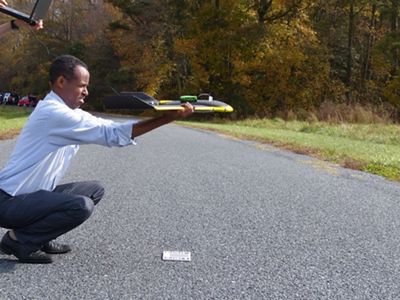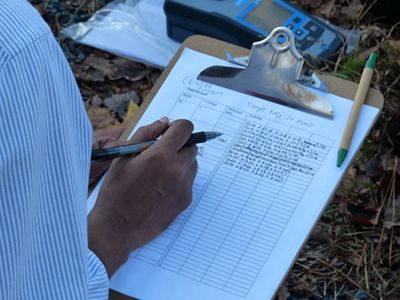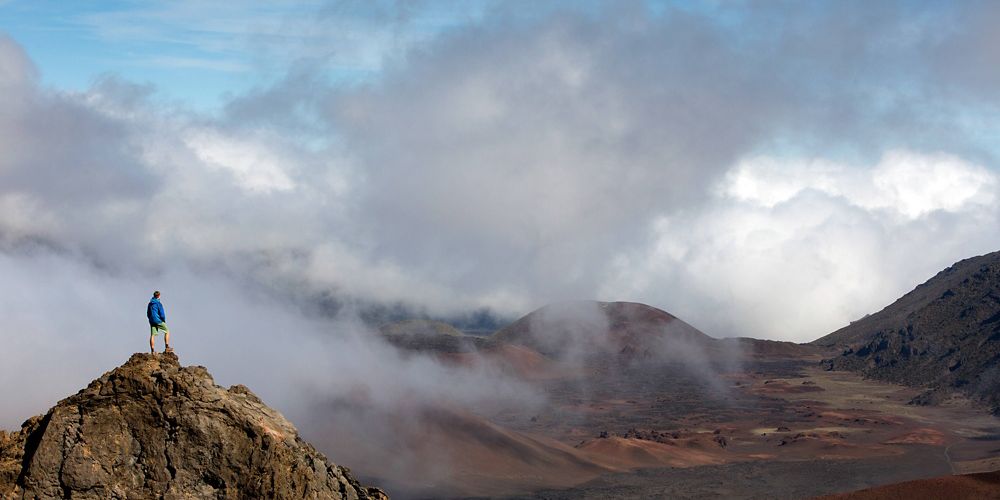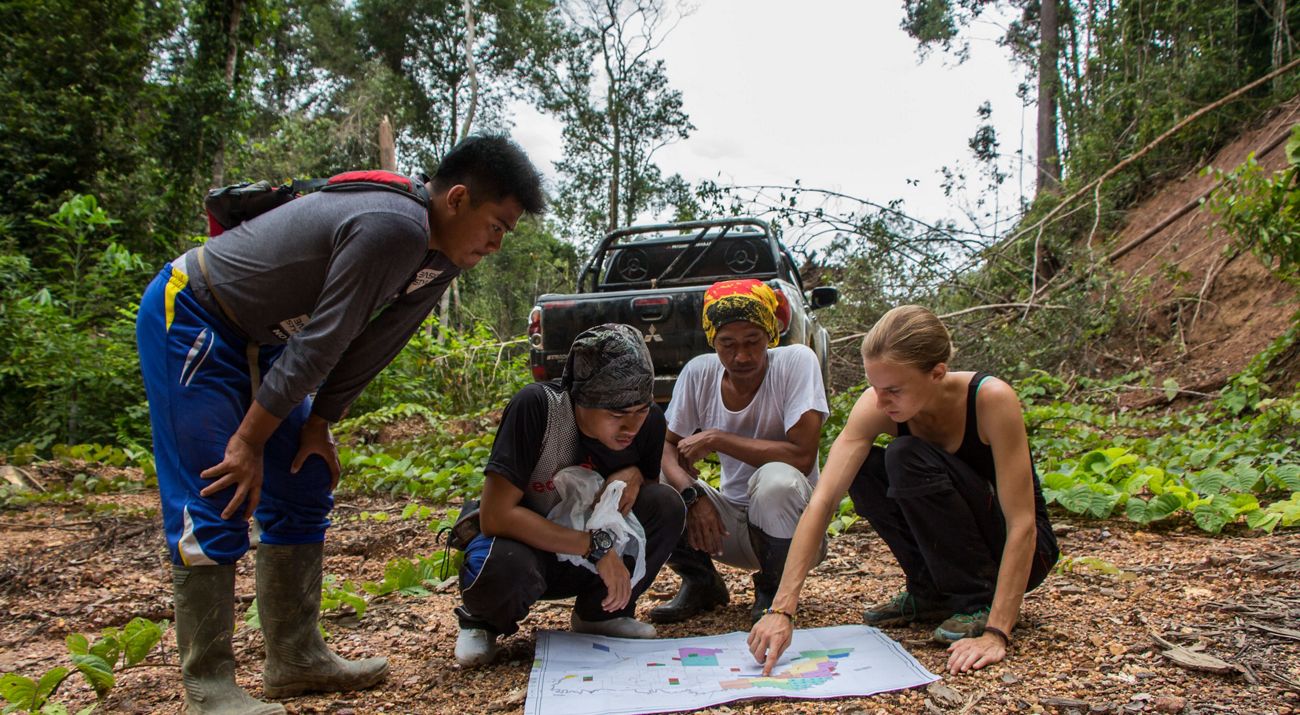Our world faces unprecedented challenges that NatureNet Science Fellows are helping solve by pushing conservation science into entirely new areas.
Program Update
The NatureNet program is no longer taking applications.
The Nature Conservancy’s NatureNet Science Fellowship operates on the principle that – to address the scope and scale of these environmental challenges – TNC needs to foster a new generation of interdisciplinary conservation science leaders.
In many ways, the world of conservation science has changed more in the last 15 years than it has in the previous 30. The 21st century is a new world for a movement once focused primarily on protecting the last, best places on Earth.
Now it’s a movement building on the work that has gone before to protect the health and function of the lands and waters we all depend on, while meeting increasing needs for food, water and energy without exacerbating global climate change and the loss of biodiversity.

At a time when many scientists are trained to enter academia or industry, NatureNet is a unique opportunity for TNC to leverage this traditional academic pathway to attract scientists with diverse backgrounds and introduce them to how their experiences and expertise can have real conservation impact.
NatureNet is also an opportunity for TNC to add new brands of science – science the blends ecology, biology, and natural resource management with climatology, physics, economics, business, chemistry, and engineering to insure we are conducting the best analyses for rapid testing and deployment of conservation solutions.

Applied Science for Lasting Conservation Results
Now in its sixth year, the NatureNet Science Fellowship awards 2-year fellowships to promising early career scientists. Each fellow is jointly mentored by a TNC field practitioner and a senior scholar from a university or accredited research institution on a project with direct application to specific TNC priorities and goals.
The fellowship provides The Nature Conservancy an unparalleled incubator for rapidly developing evidence-based conservation strategies for application to real challenges around the world. The program also offers valuable professional development and networking opportunities to fellows setting a strong foundation for building lasting relationships with former fellows as they pursue their science careers at TNC or in academia, government agencies, or at other NGOs.
NatureNet Science Fellows gain experience, test theories in the field, and further their careers at the forefront of conservation science. TNC is also able to make a wider connection to universities that often leads to opportunities for collaboration well outside the NatureNet Science Fellowship program itself.
Additionally, TNC’s commitment to working at all levels of applied conservation, from science and research to community engagement and policy implementation, means fellows can also tap the organization’s global networks and reach decision-makers in a matter of days instead of months or years.

Ideal NatureNet Candidate
The NatureNet Science Fellows program bridges academic excellence and conservation practice to create a new generation of climate change leaders who combine the rigor of academic science with real-world application. The outstanding early-career scientists and engineers in this 2-year fellowship program differ from other fellows in two major ways:
- They have prioritized improving and expanding their research skills— directing their efforts towards problems at the interface of climate, conservation, business, technology, and people;
- They are committed to their professional development— participating and applying trainings designed to improve skills in science communication, working-group facilitation, and leadership.
Seeking Innovators for Nature
The NatureNet Science Fellows program bridges academic excellence and conservation practice to create a new generation of climate change leaders who combine the rigor of academic science with real-world application.

Cohorts
The NatureNet Science Fellowship is an investment in The Nature Conservancy’s future relevance and effectiveness. Additionally, the projects undertaken by the Fellows are where the organization is making some of its most important breakthroughs in climate change science with direct application across all of The Nature Conservancy’s global priorities: lands, water, climate, oceans and cities.
Cohort Groups
-
Nine young scientists — with specialties ranging from energy infrastructure to urban ecology, Kenyan pastoral techniques to nanotechnology — were the inaugural cohort NatureNet Science Fellows, a Nature Conservancy partnership designed to help kick-start conservation toward addressing the challenges facing people and nature in the 21st century.
- Dan Auerbach, Cornell, water funds
Explore and implement methods for water fund assessment and prioritization to help determine where and how conservation investments should be made to yield the greatest returns in water quality and quantity. Mentors: Alex Flecker (Cornell), Heather Tallis, (The Nature Conservancy).
- Daniel Karp, Stanford, agriculture and conservation
Develop strategies for reconciling conservation with agricultural production, particularly through a predictive framework for how biodiversity-driven ecosystem services change in farming landscapes. Mentors: Mary Ruckelshaus (Stanford), Peter Kareiva (The Nature Conservancy).
- Rob McDonald, The Nature Conservancy, urban conservation
Develop a conceptual framework that shapes “conservation for cities” and then communicate this framework to a broad audience of urban planners, municipal officials, conservation practitioners, and academics. Mentors: TBD.
- Joanna Nelson, Stanford, water funds
Contribute hydrological modeling tools and expand current monitoring strategies so that water funds can held accountable for delivering on their promise of cleaner water through conservation. Mentors: Mary Ruckelshaus (Stanford), Adam Freed (The Nature Conservancy).
- Wilfred Odadi, Princeton, Kenyan pastoralist sustainability
Developing smart livestock grazing management and off-take strategies that enhance pastoral livelihoods and environmental conservation in northern Kenyan rangelands. Mentors: Dan Rubenstein (Princeton), Tim Tear (The Nature Conservancy).
- Efrat Sheffer, Princeton, agriculture, biodiversity and nitrogen
Explore how landscape-scale interactions between agricultural systems, abandoned fields and natural ecosystems affect biodiversity and local-scale nitrogen cycles—and determine the consequences of these interactions for downstream pollution or even “dead zones.” Mentors: Simon Levin (Princeton), Giulio Boccaletti (The Nature Conservancy).
- Anne Trainor, Yale, energy infrastructure and nature
Provide the means to implement future energy infrastructure —both traditional and renewable — across a variety of landscapes while minimizing impacts on ecosystems and biodiversity. Mentors: Oswald Schmitz (Yale), Joe Fargione (The Nature Conservancy).
- Stephanie Wear, The Nature Conservancy, oceans and wastewater
Identify and bring together solutions to address water quality issues in ways that benefit both public health and coastal habitats. Reducing sewage is good for reefs and people. Mentors: TBD.
- Sen Zhang, University of Pennsylvania, nanotechnology and sustainable energy
Developing nanotechnology for efficient and sustainable sources of energy and fuel. Mentors: Chris Murray (Penn), Jimmie Powell (The Nature Conservancy).
- Dan Auerbach, Cornell, water funds
-
Nine accomplished young scientists — with specialties ranging from nanotechnology to sustainable grazing, ocean pollution to land use and infrastructure.
Essayas Kaba Ayana, Columbia, water conflict
Project: Use spatial modeling to identify communities where mitigation and conservation measures can help prevent conflict over scarce natural resources — primarily water and pasture — in the Nile Basin.
Mentors: Ruth DeFries (Columbia), Jon Fisher (The Nature Conservancy)Trishna Dutta, Columbia, smart infrastructure development
Project: Identify areas that are critical to wildlife, as well as areas where infrastrucure development within India could happen with minimum impact on movement corridors.
Mentors: Ruth DeFries (Columbia), Jon Fisher (The Nature Conservancy)Joleah Lamb, Cornell, oceans and waste
Project: Measure the effectiveness of natural methods and management, such as bi-valve reefs, mangroves, and seagrasses, for mitigating the spread of run-off pollution that causes infectious disease in the coral reefs of Indonesia.
Mentors: C. Drew Harvell (Cornell), Stephanie Wear (The Nature Conservancy)Megan McSherry, Princeton, soil carbon
Project: Explore how smart grazing strategies in the Kenyan rangelands could promote conservation while providing a livelihood to pastoralists through soil carbon credits.
Mentors: Dan Rubenstein (Princeton), Tim Boucher (The Nature Conservancy)Spencer Meyer, Yale, forest conservation and clean water
Project: Create spatial models to optimize forest conservation for the lasting protection of water quality and supply, and enable communities to make the most effective use of conservation and natural infrastructure investments.
Mentors: Brad Gentry (Yale), Jen Molnar (The Nature Conservancy)Michael Pennino, Princeton, land use and water quality
Project: Advance sustainable development by linking patterns of land use and infrastructure (roads, sewers) with measures of water quality to develop a rigorous framework for prioritizing management decisions and selecting conservation techniques.
Mentors: Peter Jaffe (Princeton), Rob McDonald (The Nature Conservancy)Won-Hee Ryu, Yale, efficient solar energy
Project: Develop an organic polymer solar cell that can compete with more expensive silicon cells in energy efficiency with minimum production of waste and toxic byproducts.
Mentors: Andre Taylor (Yale), Jen Molnar (The Nature Conservancy)Haoran Yang, University of Pennsylvania, nanotechnology for energy and clean water
Project: Improve global sustainability by developing green nanotechnology-based solutions for pressing environmental challenges, including energy production and water treatment.
Mentors: Chris Murray (University of Pennsylvania), Peter Kareiva (The Nature Conservancy)Mingliang Zhang, University of Pennsylvania, nanotechnology for clean water
Project: Develop a system that uses nanoparticles with magnetic cores to remove chemicals and pathogens from water.
Mentors: Chris Murray (University of Pennsylvania), Peter Kareiva (The Nature Conservancy) -
Many 2015 NatureNet Science Fellows use tools, techniques and theories that weren’t even dreamt of as little as five years ago. In projects from New York to Costa Rica, Kenya to Ghana, the Fellows developed and field tested solutions-based science, including projects to:
- Develop completely new, highly efficient photovoltaic clean energy technologies and devices based on the light-scattering cells of giant clams;
- Eliminate grazing conflicts between domestic livestock and the iconic animals of Africa’s grasslands using novel methods of DNA analysis; and
- Develop the first comprehensive water management plan for the entire state of New York using new hydroeconomic models.
Maura Allaire (Columbia, water supply and management) Allaire is developing the first comprehensive approach to water management for the entire state of New York by creating a new hydroeconomic model that accounts for hydrologic estimations of state-wide stream flows, economic measures, and links between water use, land use, and economic activity.
Aaron Iverson (Cornell, expanding sustainable food production) Iverson is advancing sustainable agriculture by developing quantified models that help farmers simultaneously limit toxic agrochemicals, produce sufficient food, and provide the best returns in three key areas: economic profitability, biodiversity conservation, and the protection of ecosystem services.
Tyler Kartzinel (Princeton, harmonizing human-wildlife-livestock co-existence) Kartzinel seeks to protect the livelihoods of pastoralists and the biodiversity of Africa’s Central Grasslands by enabling range managers to predict and mitigate potential wildlife-livestock competition among herbivores through the use of novel broad-spectrum DNA-based analysis that forensically identifies which plants different species are eating, as well as where and when they’re grazing.
Chase Mendenhall (Stanford, develop and test a new theory of biogeography) Mendenhall’s work will improve the application of conservation science in the real world by field testing a new framework of countryside biogeography that, unlike the prevailing theory of island biogeography, accurately accounts for the influences human-made habitats — like farmland — have on wildlife, and equip conservation scientists and policymakers with much-needed tools to better assess the true tradeoffs between wildlife habitat and food production.
Sanaz Vahidinia (University of Pennsylvania, developing nature-inspired clean energy technologies) Vahidinia’s work focuses on engineering new photovoltaic and photobioreactant clean energy materials and devices that radically improve solar energy efficiency by understanding and adapting the sophisticated light-scattering cells of Giant Clams.
Stephen Wood (Yale, managing soils for sustainable agriculture) Wood will enable farmers in Africa’s Green Revolution to manage their farms and secure the food they need without damaging the ecosystems they also need by combining new research in soil ecology, as well as qualitative and quantitative social science, to develop ag management practices that sustain crop production, soil health and protect associated ecosystems.
-
The Nature Conservancy’s fourth cohort of NatureNet Science Fellows included eight promising, early career scientists whose work addresses the greatest challenge of our time: climate change. Each Fellow’s project focused on a specific aspect related to mitigating or adapting to climate change, from clean energy technologies, to developing new science for carbon storage and climate-smart agriculture.
Representing many of the world’s premier universities, the Fellows in the 2016 cohort worked from Africa to North America, coral reefs to tropical forests, and from laboratories to farm fields on projects to:
- develop a simple, inexpensive and environmentally friendly methodology for recycling the rare earth metals that are vital to renewable and clean energy technologies;
- mitigate climate change by developing cost-effective ways to manage secondary forest succession to increase long-term carbon storage capacity by as much as 50 percent;
- develop a crop redistribution framework that optimizes ‘climate-smart’ agriculture by simultaneously maximizing food production and minimizing water use for irrigation.
Kyle Davis (Columbia University) To increase the resilience of farmers and food production to climate change, Davis is developing a crop redistribution framework that optimizes agriculture based on the dual criteria of maximizing production (tons, calories or protein) while minimizing irrigation water use. The framework also incorporates measures to ensure new crop distributions remain economically viable for farmers.
Huayi Fang (University of Pennsylvania) Fang is developing a simple, inexpensive and environmentally friendly methodology for recycling rare earth metals. The goal of his work is to stabilize and provide a sustainable supply chain for the rare earth materials that are critically important to the technologies used in the clean energy industry, including wind turbines, solar cells, batteries and electric motors.
Kelly Gravuer (Arizona State University) Gravuer seeks to bolster participation in, and the effectiveness of, California’s cropland and rangeland climate mitigation programs by analyzing both the ecological effects of climate mitigation practices and the social factors that either promote or limit their adoption by working land managers, like farmers and ranchers.
Marc Mayes (Princeton University) Mayes will help communities in semi-arid landscapes around the world adapt to climate change by using high-resolution remote sensing technologies (including UAVs) to assess and model how different land uses and a changing climate affect ecosystem services, including carbon storage, water supply and nutrient cycles.
Anna Sugiyama (Yale University) Sugiyama seeks to mitigate climate change by developing a cost-effective methodology to manage secondary tropical forest succession that could increase long-term carbon storage capacity by as much as 50 percent. Her work explores if and how planting native trees that have both high wood density and low vulnerability to changing climate conditions can be balanced and optimized for cost, carbon sequestration and ecological function.
Daniel Swain (University of California-Los Angeles) Swain uses sophisticated computer models to characterize climate change-driven precipitation extremes (drought and flood) and provide actionable, science-based insights for decision-makers who are responsible for adapting to regional changes in climate already underway.
Shannan Sweet (Cornell University) Sweet uses technologies, including geospatial analysis and spectral image processing, to help farmers adapt to climate change by developing and incentivizing the adoption of “climate-smart” agricultural practices.
Kira Sullivan-Wiley (Brown University) Sullivan-Wiley examines the indirect social and ecological consequences of Payment for Ecosystems Services programs to enable more thorough evaluation and quantification of the ways these programs (like Water Funds) can contribute most effectively to conservation and climate change mitigation.
-
Holly Buck (University of California—Los Angeles) Buck will conduct a feasibility study of the adoption and implementation of solar geoengineering strategies by policy-makers, institutions, and general society. These strategies will help counter rising global temperatures by reducing the amount of sunlight that reaches Earth and its atmosphere. Through interviews of stakeholders her goal is to determine how policies on solar geoengineering should be designed so that environmental and community impacts are incorporated.
Zuzana Burivalova (Princeton University) Burivalova will use bioacoustics, the sounds animals make when communicating with each other, to develop an inexpensive and simple tool to measure biodiversity in tropical forests. Expanding on her current work which suggests that soundscapes are less saturated with sound as human disturbance increases, Burivalova intends for her work to be used in sustainable forest management and support practices that keep forests as forests.
Clare Kazanski (University of Minnesota) Conservation-grazing is gaining popularity as a practice of producing more forage for cattle while theoretically maintaining habitat with more biodiversity and carbon storage. Kazanski plans to assess the effects conservation-grazing strategies on carbon storage and investigate if site conditions, land-use history, and local plant adaptations have an effect on the impact of different grazing strategies in order to prioritize management.
Ashley Keiser (University of Minnesota) Keiser’s work will attempt to quantify the amount of soil carbon needed to minimize nitrogen loss while simultaneously maintaining productivity in agricultural systems. She intends to use these results to develop soil health metrics for nitrogen management practices in an effort to increase water quality and mitigate climate change.
Anand Osuri (Columbia University) Using a combination of satellite image analyses, modelling, and field-work, Osuri seeks to inform best-practices for tropical forest restoration, an important strategy worldwide for mitigating climate change. His work will compare two common reforestation practices, planting species-rich forests versus monoculture plantations, to determine if species-rich forests are less sensitive to disturbances such as droughts, thereby providing more reliable carbon sequestration benefits.
Johanne Pelletier (Cornell University) Pelletier’s research investigates if Zambia’s wood energy supply can be sustainably managed in a manner that will continue to fulfill the country’s growing energy demand while promoting low-carbon development. Pelletier’s ultimate goal is to be able to predict the impacts of socio-economic development, forest cover change, and greenhouse gas emissions on wood energy and test policy scenarios that may help in developing sustainable wood energy practices.
Robert Rossi (Stanford University) Rossi’s research will focus on one of the largest outstanding questions in soil carbon dynamics, the constraints imposed by limited oxygen on organic matter decomposition and its impacts on carbon turnover and greenhouse gas emissions in soils. This work will provide a framework for developing management recommendations to maximize soil carbon storage while minimizing greenhouse gas emissions.
Jonathan Walter (University of Virginia) Walter’s work will look at North American bird species and determine how they are currently synchronized to fruiting vegetation and insect abundance and evaluate if birds are becoming asynchronous (showing up too early or late) due to climate change. Ultimately his work will be used to determine what areas should be a conservation priority based on their importance to birds across the landscape.
Chenjie Zeng (University of Pennsylvania) Taking advantage of current advancements in nanotechnology, Zeng’s research aims to develop low-cost and efficient solar “paint or ink” as an alternative to traditional solar cells. Her promising work opens doors to solar cells that can be painted on large surface areas such as buildings, cars, and roads, taking advantage of existing infrastructure and development.
-
Megan Kelso (UCLA) Mitigating climate change and improving food security through mangrove conservation in Indonesia.
TNC Mentors: Edward Game, Global Science and Heather Tallis, Global Science
University Mentors: Miriam Marlier, Kyle Cavanaugh, and Daniela Cusack
Megan studies Indonesian mangroves, which are stunningly diverse coastal wetland forests that support critical fisheries and store carbon more effectively than almost any other ecosystem. Her research quantifies how mangrove conservation would impact local food security and carbon storage by comparing the benefits from mangroves to those from shrimp aquaculture ponds, the main alternative land use driving loss of mangroves in Indonesia.
Danica Schaffer-Smith (Arizona State University) Adapting to climate change in intensified agricultural watersheds: Minimizing nutrient pollution risk under flood and hurricane events in the Cape Fear River Watershed
TNC Mentors: Julie DeMeester, North Carolina Chapter
University Mentors: Soe Myint and Rebecca Muenich
Danica’s research investigates the nutrient pollution risk associated with intensified agriculture, such as concentrated animal feeding operations, under ongoing climate change related events like increased flooding and hurricanes. She also considers where nature-based land and water management interventions should be implemented to most effectively improve water quality and prevent flooding.
Diana Rypkema (Cornell) Coping with extreme climate: Ecosystem service modeling for conservation planning in Gabon and the Okavango Basin
TNC Mentors: Tracy Baker, Africa Program
University Mentors: Suresh Sethi and Patrick Sullivan
Rypkema will work with the Africa Program to assess regional risks to human well-being and biodiversity posed by climate change, evaluating possible management strategies and regional development scenarios to meet stakeholder goals while supporting both human and environmental needs.
Robert Higgins (UPenn) Novel separations of rare earths using magnetic and electro-kinetic methods.
TNC Mentors: Timm Kroeger, Global Science and Martha Rogers, Center for Sustainability Science
University Mentors: Eric Schelter
Rare earth ions are used for technologies from data storage to wind turbines; unfortunately, purification of these ions from one another is a difficult and environmentally taxing process that requires multiple iterations. To address these challenges, Robert is investigating new methods to separate rare earths from waste materials and minerals in an environmentally friendly, single step process using their intrinsic magnetic properties.
Research Grants
Collin Phillips (Northwestern) Impacts of climate and hydropower development on river flow
TNC Mentors: Hector Angarita, Northern Andes and South Central America Conservation Programs
University Mentor: Aaron Packman and Chris Paola
Large increases in river hydropower are projected for future energy needs and these low-carbon energy sources represent important components of climate change mitigation strategies, however the installation of dams can result in significant negative impacts on river ecosystems. Phillips will explore how rivers within the Magdalena River basin, a complex and critical natural resource in Columbia, route water, sediment, and nutrients to provide a general framework for minimizing the impacts of hydropower development and climate change on river ecosystems.
Jacqueline N. Kariithi (Princeton) Promoting sustainable intensification of agriculture in Kenya
TNC Mentor: Felix Kamau, Africa Program
University Mentor: Daniel Rubenstein
Jacqueline's research will examine the ‘yield to cost’ outputs from growing cereal crops in the Mt Elgon region of Kenya’ by comparing traditional methods for increasing agricultural production verses sustainable and climate resilient methods. The ultimate goal is to produce evidence that can assist local farming communities in identifying sustainable production methods that result in increased productivity and improved livelihoods.
Whitney Friedman (UCSB)
-
Jeremy Simmonds (University of Queensland)
TNC Mentor: James Fitzsimons
University Mentor: Martine Maron
Project Description: Embedding conservation of biodiversity and cultural values in strategic planning for northern Australia
Skuyler Herzog (Indiana University)
TNC Mentor: Emily Howe
University Mentor: Ed Kolodziej
Project Description: Triaging urban stream systems for the future:
Hyporheic restoration
Krishnapriya Parameswaran Perumbillissery (Duke University)
TNC Mentor: Priya Shyamsundar
University Mentor: Subhrendu K Pattanayak
Project Description: Examining farmer adoption of conservation agriculture in India
Rose Graves (Portland State University)
TNC Mentor: Ryan Haugo
University Mentor: Max Nielsen-Pincus
Project Description: Natural Climate Solution Strategies for the Pacific Northwest
Sarah Skikne (University of Minnesota)
TNC Mentor: Mark Anderson
University Mentor: Jessica Hellmann
Project Description: Range shifts in resilient and connected landscapes
Rachel Smith (University of Virginia)
TNC Mentor: Jill Bieri and Bowdoin Lusk
University Mentor: Max Castorani
Project Description: Resilience and spatial dynamics of recovering oyster reefs
Vidya Venkataramanan (Northwestern University)
TNC Mentor: Rob McDonald
University Mentor: Sera Young
Project Description: Monitoring human well-being after natural infrastructure installation

Additional NatureNet Resources
Request for Proposals for the Next NatureNet Cohort
Project & Mentor List
Legal Documentation
Additional Information
Application Portal Page
